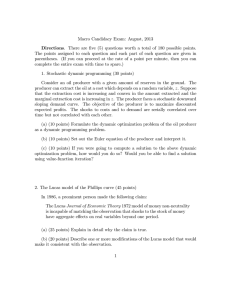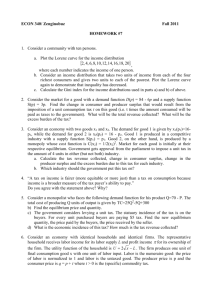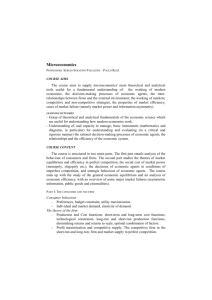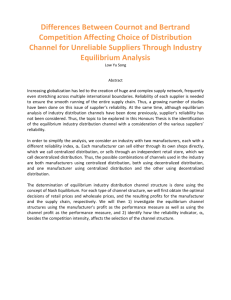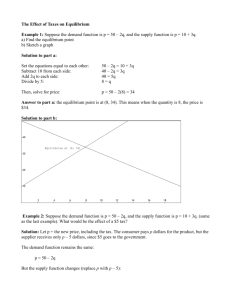Economics 324
advertisement
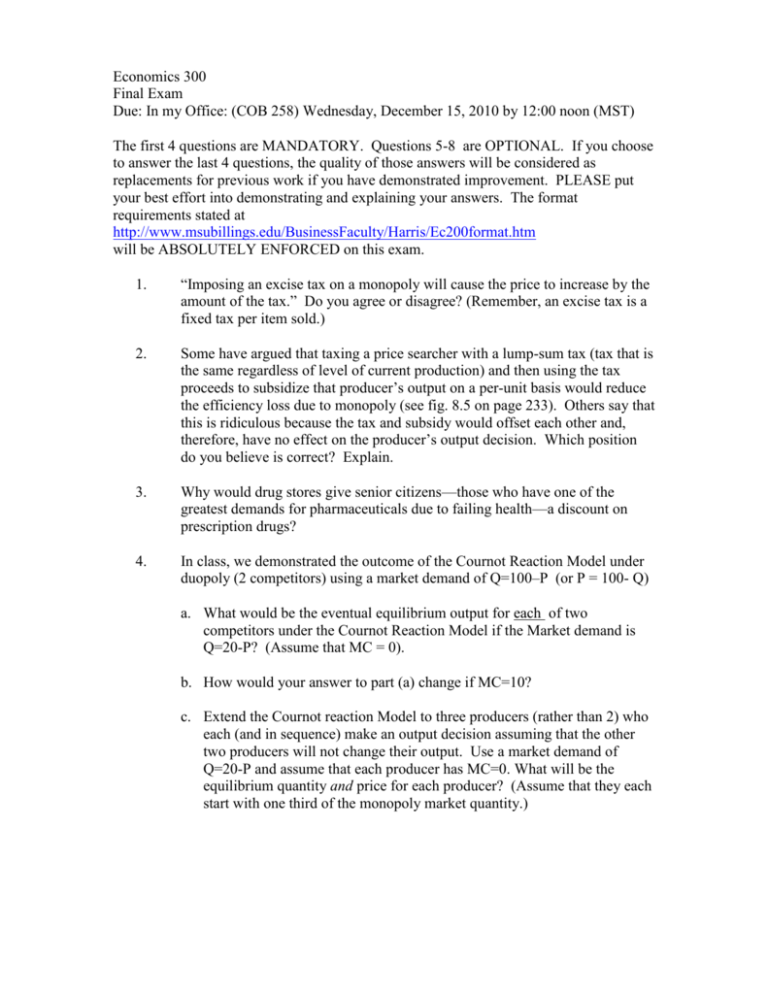
Economics 300 Final Exam Due: In my Office: (COB 258) Wednesday, December 15, 2010 by 12:00 noon (MST) The first 4 questions are MANDATORY. Questions 5-8 are OPTIONAL. If you choose to answer the last 4 questions, the quality of those answers will be considered as replacements for previous work if you have demonstrated improvement. PLEASE put your best effort into demonstrating and explaining your answers. The format requirements stated at http://www.msubillings.edu/BusinessFaculty/Harris/Ec200format.htm will be ABSOLUTELY ENFORCED on this exam. 1. “Imposing an excise tax on a monopoly will cause the price to increase by the amount of the tax.” Do you agree or disagree? (Remember, an excise tax is a fixed tax per item sold.) 2. Some have argued that taxing a price searcher with a lump-sum tax (tax that is the same regardless of level of current production) and then using the tax proceeds to subsidize that producer’s output on a per-unit basis would reduce the efficiency loss due to monopoly (see fig. 8.5 on page 233). Others say that this is ridiculous because the tax and subsidy would offset each other and, therefore, have no effect on the producer’s output decision. Which position do you believe is correct? Explain. 3. Why would drug stores give senior citizens—those who have one of the greatest demands for pharmaceuticals due to failing health—a discount on prescription drugs? 4. In class, we demonstrated the outcome of the Cournot Reaction Model under duopoly (2 competitors) using a market demand of Q=100–P (or P = 100- Q) a. What would be the eventual equilibrium output for each of two competitors under the Cournot Reaction Model if the Market demand is Q=20-P? (Assume that MC = 0). b. How would your answer to part (a) change if MC=10? c. Extend the Cournot reaction Model to three producers (rather than 2) who each (and in sequence) make an output decision assuming that the other two producers will not change their output. Use a market demand of Q=20-P and assume that each producer has MC=0. What will be the equilibrium quantity and price for each producer? (Assume that they each start with one third of the monopoly market quantity.) Optional Questions. 5. A consumer has the choice of consuming two goods, x and y. If a tax is placed on purchases of x only, how will that affect the budget constraint for this consumer? Is it possible for this consumer to choose to consume more of good x after the tax than before? If not explain why not, if yes, explain the characteristics of good x that are necessary for this to occur. If goods x and y are perfect substitutes in consumption, show how a tax on x alone could cause the rational consumer (who was purchasing x before the tax) to choose to purchase no x at all after the tax is imposed 6. Using the Hicks Decomposition, demonstrate the income and substitution effects for a good that is inferior, but is not a Giffen good. 7. In a price taker’s market why would a producer ever plan to produce less than that which minimizes the LRAC (shown as output q2 in figure 6.5 in your text)? Or would they? Explain thoroughly. 8. Gary has been a bad boy. It seems he’s hidden something that a lot of people would like to find. In order to get the truth from Gary, his parents decide to have their neighbor Connie (a policewoman) ask him questions. Gary can either tell the truth or lie. Connie can act either tough or soft. Thus, the game they face is: Gary Truth Lie Connie Tough Soft A,E B,F C,G D,H a. Explain a relationship between A, B, C, D, and E, F, G, H that will make Lie, Soft a Dominant Strategy Equilibrium. b. Explain a relationship between A, B, C, D, and E,F,G,H that will make Lie, Soft a Nash Equilibrium but NOT a Dominant Strategy Equilibrium. (By “relationship between A, B, C, D” let me know pair wise what the necessary relationships would be…e.g., is A > B or is B > A? If the relationship does not matter, indicate that.)

